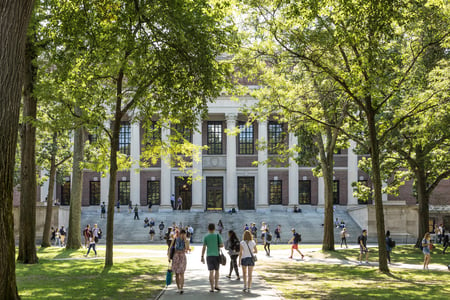
August 7 2018
Contributors: Steve Morley, Michelle Samuels-Jones, and Joe Henry-Penrose
This blog is based off the authors’ responses to this Hidden Brain podcast episode.
As the summer ends and new students arrive, institutions expect to see a small percentage drop off their radar. However, recent research shows that as many as 20% of high school graduates that intend on matriculating, do not actually go on to college; this phenomenon is known as summer melt. In many cases these are students who "melt away" are well prepared for college and have worked for years with college at the forefront of their minds. So, why are they stumbling at the finish line?
Rather than just asking how to reduce summer melt, we suggest asking the following questions:
- What are we doing to help our students through the steps of successful matriculation at our institutions this fall?
- What tools are we providing to our students to help them be successful in this process?
- How might these tools also provide applicable lessons to students once they are in college; e.g., how can we model and teach problem solving and navigating challenges?
At Credo, we encounter issues of summer melt often in our Student Success assessments or in our Moving the Needle retention work. A common solution that we recommend comes as a result of these partnerships: the Clearance Module, in which we work to improve our clearance processes so that the business of being a student is far more about learning, and far less about forms and paperwork.
Rather than asking if these students are ready for college, perhaps we should be asking if our colleges are ready for these students. What can our colleges do to increase their college readiness and equip their students for success in the matriculation process?
It simply comes down to four steps.
1) Identify the points of friction in your admissions process.

While large roadblocks are regularly the reason why students melt away, these large issues are often the culmination of many smaller barriers to entry. Try taking yourself through the admissions process at your institution and put yourself in the place of a student who has no outside help. Are you able to smoothly identify what forms you need to fill out? Ask yourself if a student could compete the admissions process on their own, or if they would need a lot of outside help to navigate the process and explain what things are and what they mean.
Implement clear clearance processes to remedy any road blocks or confusing pieces of the process. Clearance includes an aligned and integrated approach, communication strategy, and “tracking” system across key student service functions to better equip students and their families to address what they are required to do to fully matriculate each semester. Intentional efforts in this area dramatically increase students’ successful transition into and on-going persistence in campus community. Track how students move through your process and identify areas that slow the admissions process or cause (potential) students to drop off of your radar.
2) Eliminate non-essential issues.

While some of the friction that you find will be impossible to eliminate, other pieces will be eliminable. If you cannot remove a barrier for some students, try to find a method of asking a similar question that may be easier for some students. For instance, if your institution asks for the signature of a parent, find out if you legally need a parent’s signature, and if not, ask for the signature of the student themselves instead. If you typically require students to walk all around campus to obtain dean and department head signatures, ask yourself if that is even necessary, and if so, if deans and department heads could provide e-signatures via an online queuing system.
3) Find ways to empower students with tools to solve issues for themselves.

As students become more accustomed to on-demand information and results we must create tools to accommodate this change. Creating wikis, answer bases, and even chatbots are wonderful ways to decrease calls, allow students to quickly answer their own questions without feeling judged, and help solve small issues that can stop a student from attending.
There is a lot of information, direction, and guidance we leave up to students/families to figure out. Even in cases where we are sending out a lot of information, there may still be a gap in students/families understanding of what is received, what they need to do with it, how, and why it matters. As the percentages of first-generation students continue to increase, it will be critical we not only communicate what to do, but provide guidance on how to do it and the meaning behind why we ask them to do it in the first place. Video tutorials, online wikis with definitions, webinars, and chatbots all help to ease the onus on students, especially those in precarious positions.
4) Carry these approaches throughout the First-Year Experience.

An integral, but often forgotten, area we focus on to address Summer Melt is the development of a robust First-Year Experience. We define the time period of the FYE as the point of acceptance through the first day of the second year. We ask, how is the campus community aligned and sequenced over this entire time period to ensure students are developing a strong sense of identity? How are we fostering connectedness to the institution, both academically and socially, as well as connectedness with their peers? Are students experiencing “real time” practical examples/situations that affirm their choice? Aim to create an experience that results in students wanting to stay rather than merely solving an issue.
Do you and your team feel up to the task of streamlining communications, providing increased services, and retooling your clearance process and first-year experience? If you're not sure, it may be time to talk to a strategist in the field. Talk to a Credo Consultant about how to move your institution forward with a dynamic plan to clear students, and then retain them through not only their first year, but also to graduation.
Related Blog Posts
Recent Posts
- Richard Dunsworth, J.D., To Receive 12th Annual Courageous Leadership Award December 16 2024
- Meet the 2024 Credo Values Award Recipients August 27 2024
- What is Executive Coaching, Really? June 25 2024
- Credo & The Constructive Dialogue Institute Announce A New Partnership For Higher Education Leadership Development March 7 2024
- Celebrating Women And Gender-Diverse Learners & Leaders February 28 2024
Categories
- Strategy
- Leadership
- Student Success
- Student Success & Retention
- Enrollment
- Pivot
- Strategic Planning
- Leadership Development
- News
- Strategic Enrollment
- Campus Planning and Architecture
- Moving the Needle
- Data
- Research
- Retention
- Campus Master Planning
- Enrollment & Financial Aid
- Academic Programming
- Campus Planning
- Thriving
- Admitted Student Research
- Architecture
- Finance
- Advising
- Admissions



